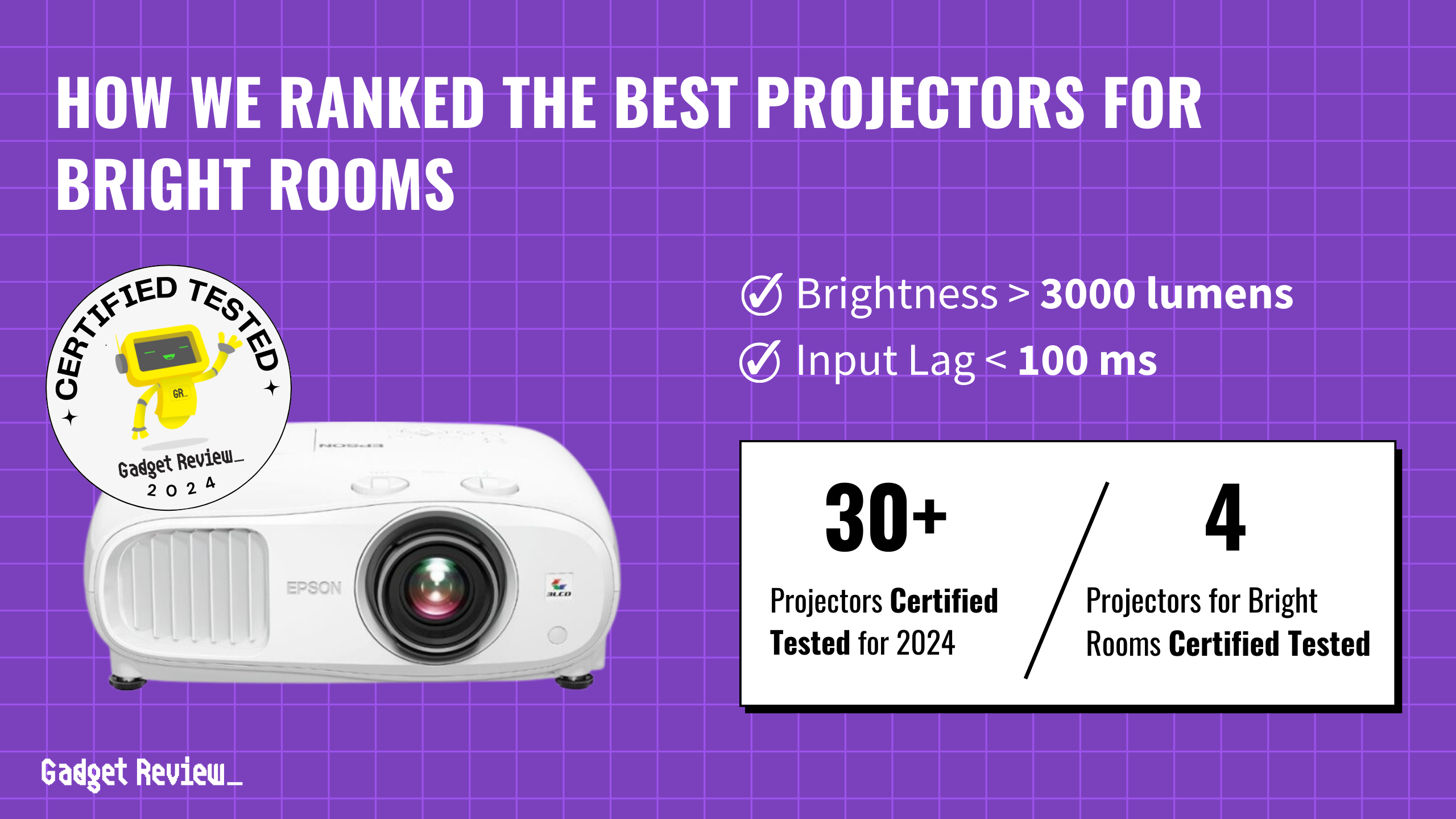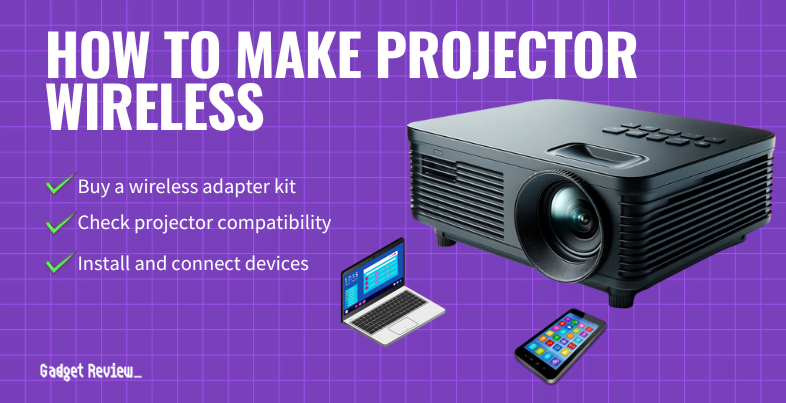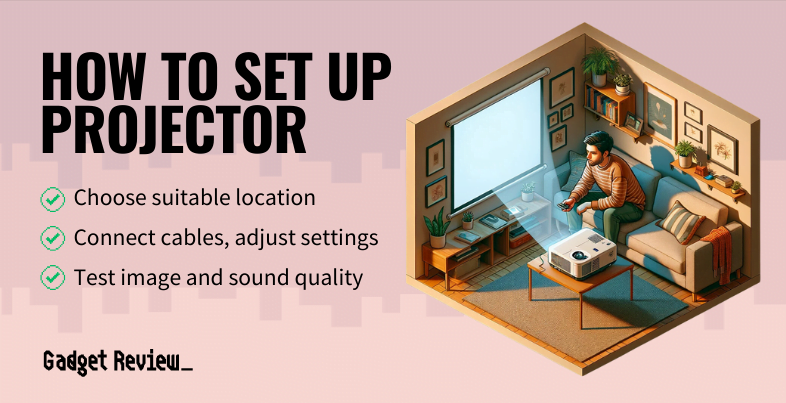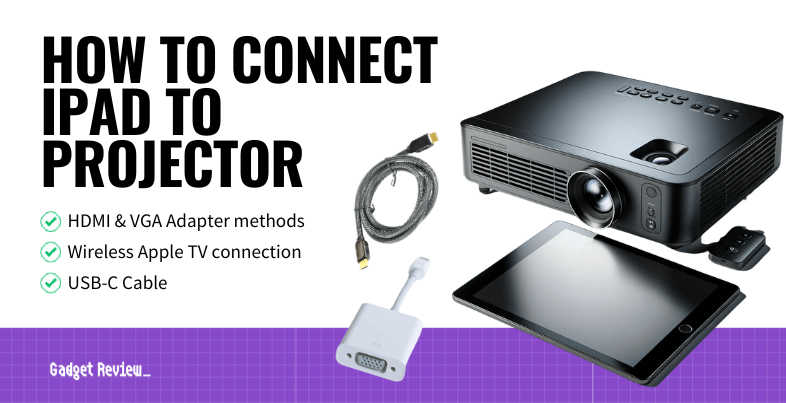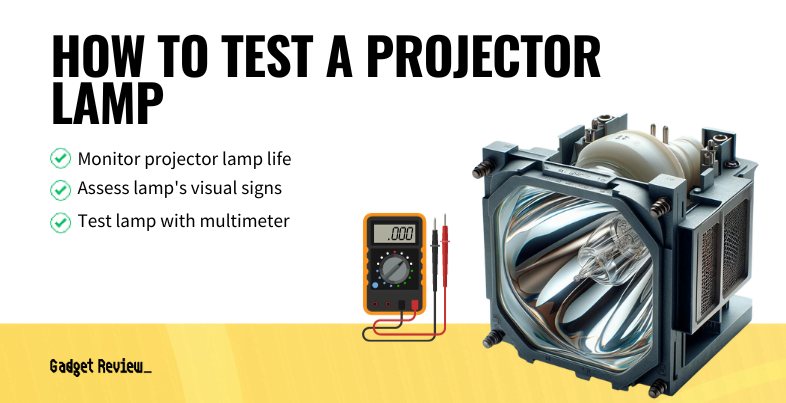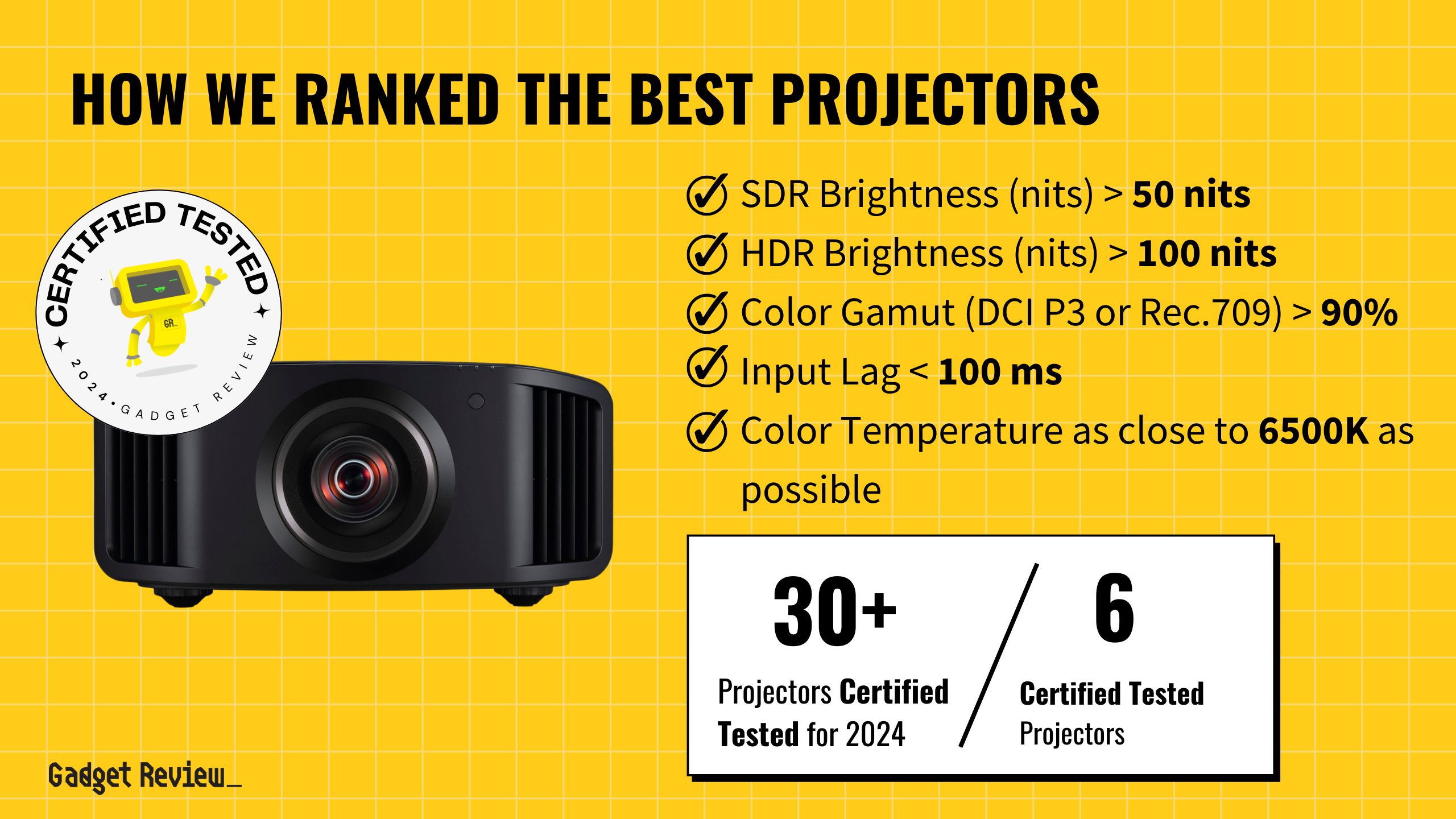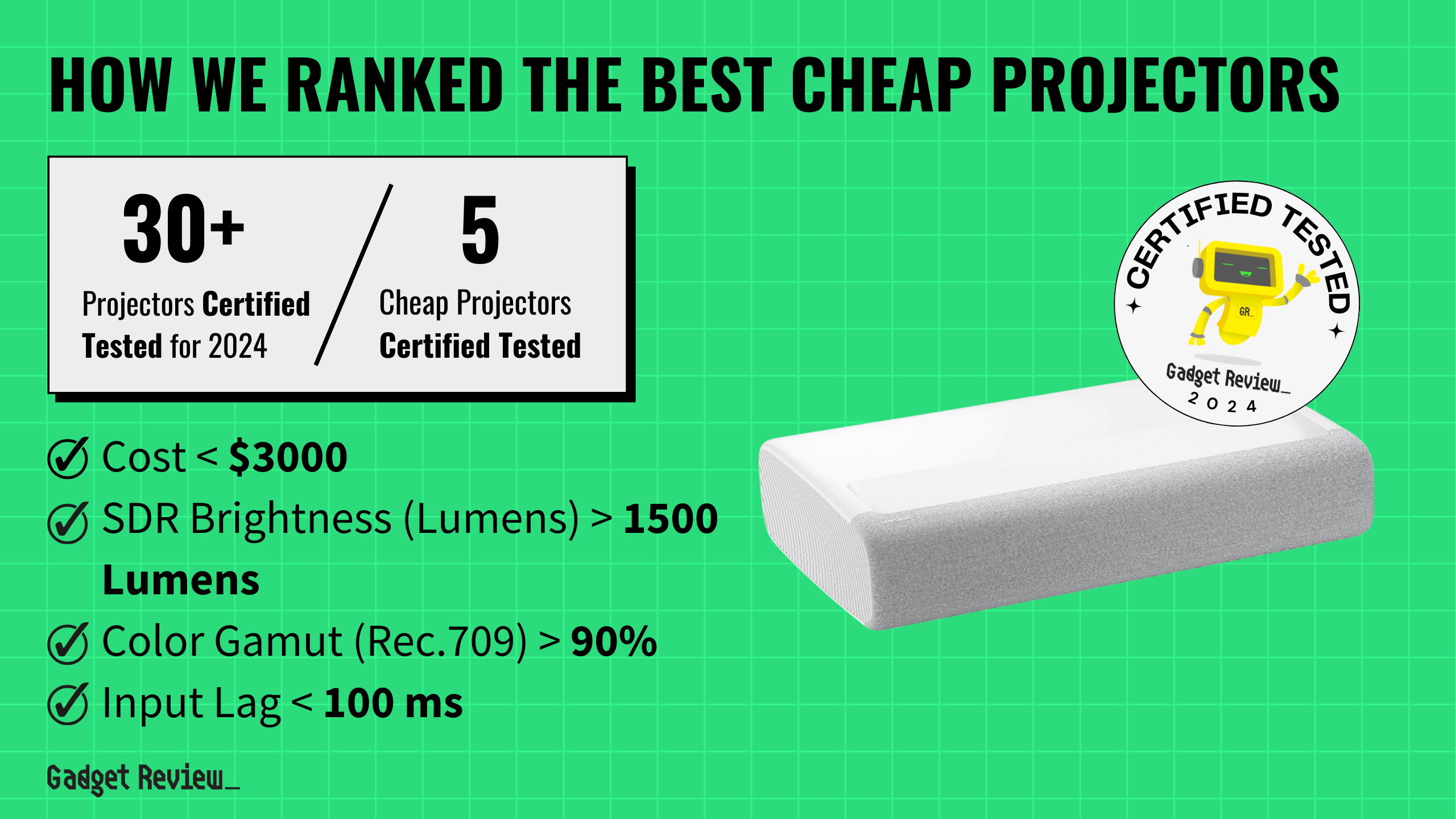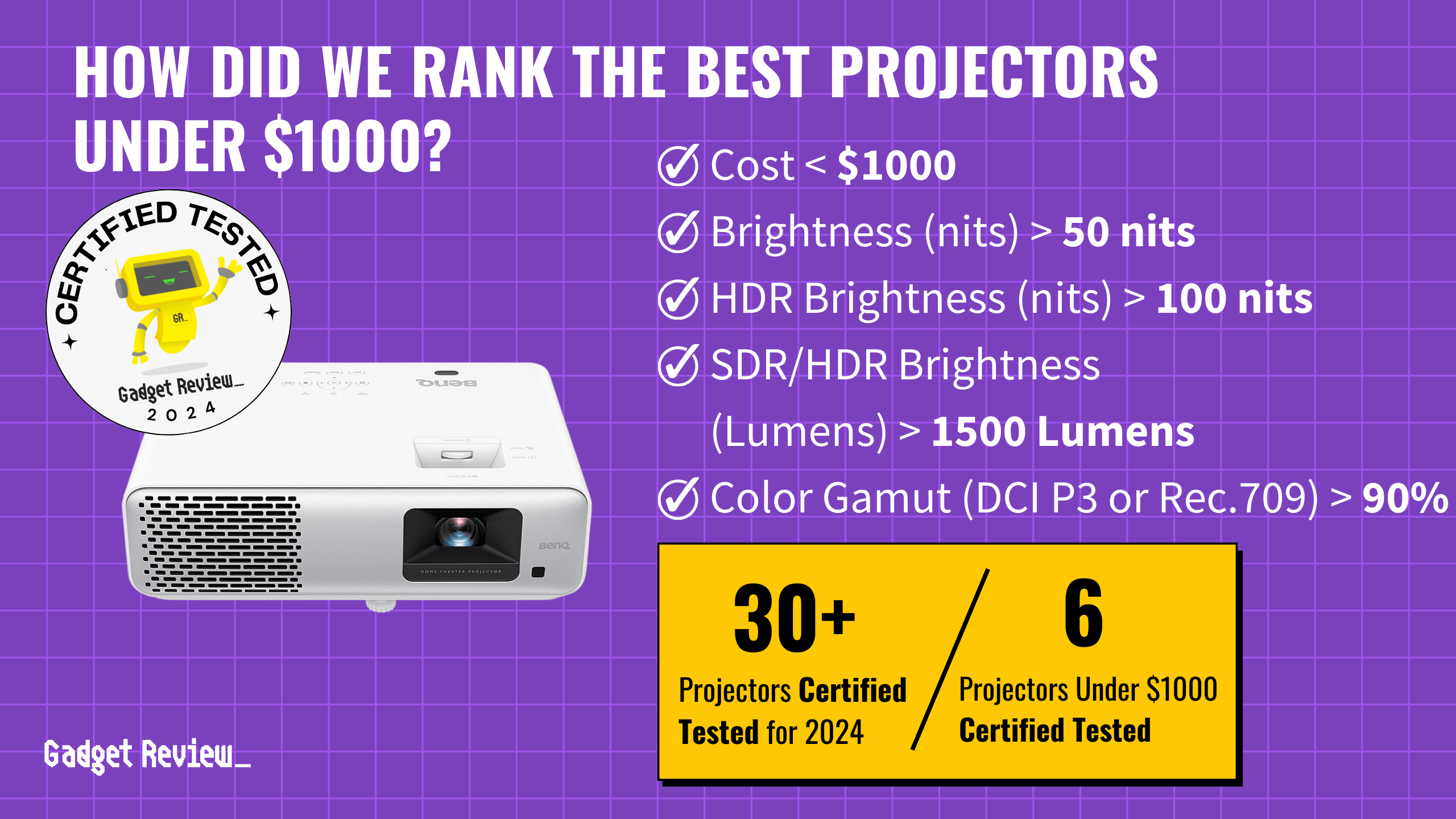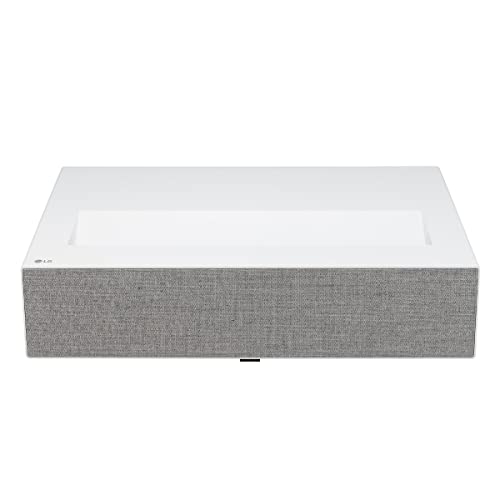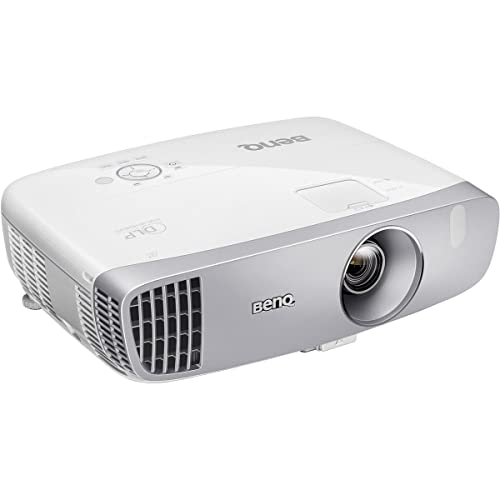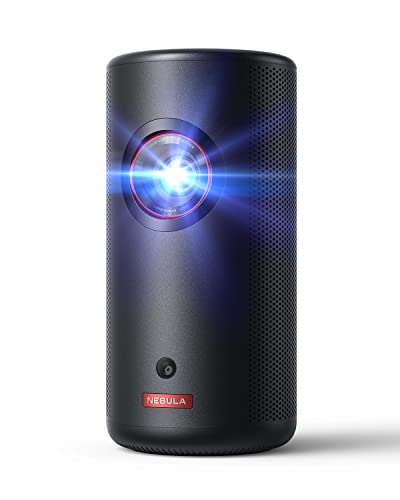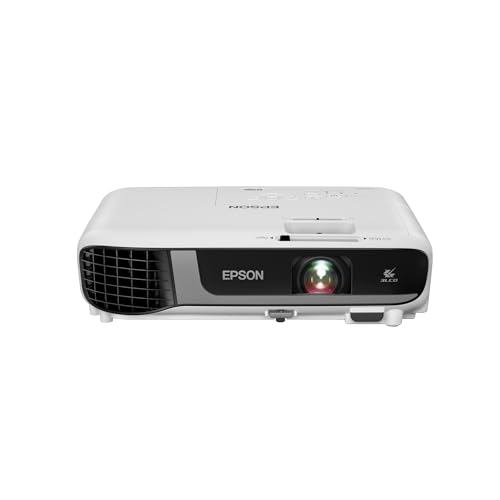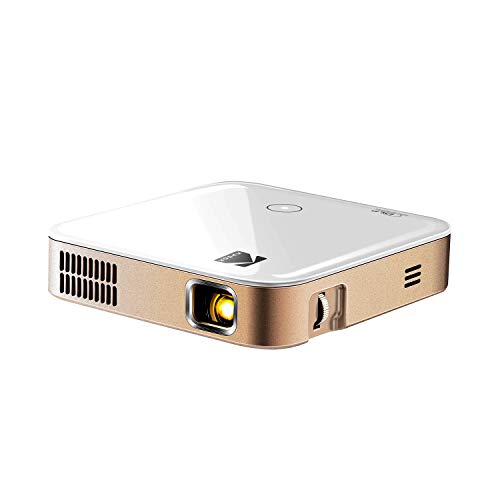When you’re selecting a projector for a bright room, it’s crucial to focus on brightness and clarity. Look for one with over 2000 lumens – it’ll give you vibrant, clear images even when the room is well-lit. Also, aim for an input lag under 100 milliseconds for smooth, responsive visuals. Our buying guide features four projectors that excel in these criteria.
We evaluated over 30 models and analyzed 10,302 reviews to ensure accuracy. Our scientifically proven True Score system filters out fake and low-quality reviews. These highly-rated projectors performed exceptionally well in tests, proving their capability to deliver bright and clear images in brightly lit rooms.
How Did We Rank the Best Projector for Bright Rooms?
To create our buying guide for the best projectors for bright rooms, we meticulously analyzed testing methodologies from over 200 websites, considered expert opinions, and scrutinized customer reviews. We honed in on critical criteria such as brightness levels, contrast ratios, and color accuracy. Our rigorous approach determined 1 required test result and 1 nice-to-have result that ensures optimal performance in well-lit environments. The result is a comprehensive guide that highlights projectors excelling in brightness and clarity, tailored for your bright room needs.
Our commitment to unbiased reviews is powered by our ‘True Score’ system, targeting low quality and fake reviews. When you shop through our links, you’re backing our mission. Dive deeper to see how.
? Test Criteria
- SDR Brightness: Equal to or greater than 2000 lumens or more to help produce a bright and clear display.
? “Nice To Haves”
- Input Lag: An input lag of less than 100 milliseconds, to prevent delays between what’s on screen and your reaction to them in games.
Latest Updates
- 06/14/2024: Republished the list to include the best projector for bright rooms based on our True Score system.
Top Projector for Bright Rooms For 2025
Prices accurate at the time of publishing

Best Overall

Runner Up

Best Value

Best Budget

Best Mid-Range

Premium Pick
BenQ X3000i
Best For Gaming
Perfect for gamers, the BenQ X3000i offers stellar performance in bright rooms with 2875 lumens and a rapid 17.2 ms input lag. It also has a 99.24% DCI P3 color gamut for vibrant colors in games and movies.
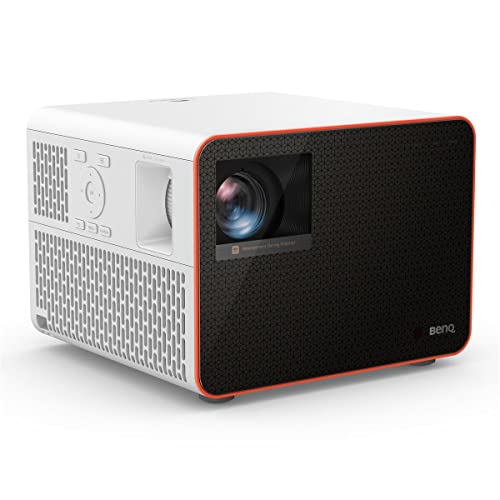
True Score
85867Experts
88352Customers
Absolutely Fresh
 SAVE $200$1,999.00$1,799.00
SAVE $200$1,999.00$1,799.00Read More
Snapshot
Reasons to Buy
- Good brightness levels
- Excellent image quality
- Exceptionally low input lag
Reasons to Avoid
- No Netflix app
Specifications

Resolution 3840 x 2160 (4k) Refresh Rate 60 Hz 
Display Technology DLP 
Contrast Ratio 500,000:1 
Digital Keystone Yes 
HDR Yes 
Max Distance 228″ 
Max Screen Size 200″ 
3D Ready Yes 
Aspect Ratio 16:9 
Brightness 3000 lumens 
Depth 10.2″ 
HDMI Type 2.0 
Height 7.8″ 
Integrated Speakers Yes 
Light Source LED 
Light Source Life 20000 hrs 
Min Distance 69.6″ 
Min Screen Size 60″ 
Noise Level 32 dB 
Portable Yes 
Smart Functionality Android TV, Bluetooth, Google Assistant, Google Cast, USB 
Sync Technology CinemaMaster 
TV Tuner No 
ThrowType Standard Throw 
Video Inputs HDMI 2.0, USB, VGA 
Weight 14.1 lbs 
Width 10.7″ All Specs
Test Results
SDR Brightness (Lumens) 2,875 HDR Brightness (Lumens) 0 Contrast Ratio (x:y) 0 Input Lag (ms) 17 Color Gamut % (Rec. 709) 0 Color Gamut % (DCI P3 uv) 99 SDR Brightness (nits) 0 HDR Brightness (nits) 0 SDR Color Temperature (K) 0 HDR Color Temperature (K) 0 Color Gamut % (Rec. 2020) 0 Color Gamut % (BT.2020) 75 Color Gamut % (BT. 709) 0 All Tests
All Retailers
- $1,799.00$1,999Save $200
- $1,999.00
Our Verdict
If you’re a gamer and need a projector that can withstand being in a bright room, the BenQ X3000i delivers both brightness and responsiveness. With an SDR brightness of 2875 lumens, this projector ensures your visuals remain clear and vibrant, even in well-lit rooms. This makes it an ideal choice for nighttime movie sessions and daytime gaming when ambient light can degrade picture quality.
In terms of gaming, the BenQ X3000i is particularly impressive thanks to its best-in-class input lag of only 17.2 milliseconds. This responsiveness is crucial for quick reaction times, especially in fast-paced competitive games where every moment counts. The outstanding 99.24% DCI P3 color gamut also means that the colors you see will be rich and deeply saturated whether you’re gaming or watching movies.
While specifically optimized for gaming, the BenQ X3000i’s capabilities make it a versatile performer across various uses. Its high brightness and superb color accuracy cater to gamers and movie enthusiasts who desire a cinema-like experience in their living room, especially if you have a brighter living room or can’t quite get it dim enough for other projectors.
The X3000i is an excellent choice if you’re looking for a gaming projector that performs exceptionally well in brightly lit and dark environments. It’s reasonably priced and delivers excellent input lag, fantastic color gamut coverage, and much-needed brightness for bright spaces.
Read Less
Category Snapshot
Projectors
- Total Brands/Products Tested
11 Brands, 30 Products
- Top 2 Brands
Epson, BenQ
- Price Range (Budget-Premium)
$350-$16,000
- Average True Score
81.36
- Important Test Criteria
Brightness (cd/m2)
Contrast Ratio (1000:1) - Most Trusted Testers

- Top Projector Experts
- Typical Warranty
1 year
- Covered by Insurance
Yes – AKKO

Best Overall

Runner Up

Best Value

Best Budget

Best Mid-Range

Premium Pick
Epson Home Cinema 3800
Best For Epson
Ideal for bright environments, the Epson Home Cinema 3800 maintains clear, vivid images with 2176 lumens of brightness and 113.7% Rec. 709 color coverage, suitable for sports and versatile living spaces.
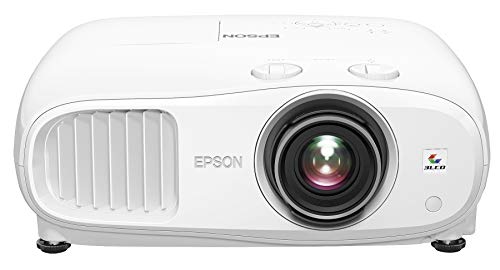
True Score
83846Experts
871kCustomers
Absolutely Fresh
 $1,660.89
$1,660.89Read More
Snapshot
Reasons to Buy
- Great brightness
- Great image quality
- 4K resolution
Reasons to Avoid
- Lacks a wide color gamut
- The lamp output may not match the specs
- Mediocre 28-ms input lag
Specifications

Resolution 1920 x 1080 (Full HD) Refresh Rate 60 Hz 
Display Technology 3LCD, LCD 
Contrast Ratio 100,000:1, 200,000:1 
Digital Keystone ± 30° (manual) 
HDR No, Yes 
Max Distance 300″ 
Max Screen Size 300″ 
3D Ready No, Yes 
Aspect Ratio – 
Brightness 3000 lumens 
Depth 13″ 
Height 6.5″ 
Integrated Speakers No, Yes 
Light Source UHP lamps 
Light Source Life 3,500 hrs 
Min Distance 0″ 
Min Screen Size 40″ No – 
Noise Level 35 dB 
Portable No, Yes 
Smart Functionality Automatic Adjustments, Bluetooth, Eco-Friendly, Energy-Saving, Remote, USB 
Sync Technology VRR 
TV Tuner No, Yes 
ThrowType 1.32 to 2.15:1. 
Video Inputs HDMI 2.0, USB, VGA 
Weight 15.2 lbs 
Width 16.1″ All Specs
Test Results
SDR Brightness (Lumens) 2,176 HDR Brightness (Lumens) 0 Contrast Ratio (x:y) 24k Input Lag (ms) 28 Color Gamut % (Rec. 709) 114 Color Gamut % (DCI P3 uv) 77 SDR Brightness (nits) 275 HDR Brightness (nits) 235 SDR Color Temperature (K) 0 HDR Color Temperature (K) 0 Color Gamut % (Rec. 2020) 0 Color Gamut % (BT.2020) 0 Color Gamut % (BT. 709) 0 All Tests
All Retailers
- $1,660.89
- $1,699.99
- $1,699.99
- $1,699.99
Our Verdict
If you cannot adequately dim where you’re going to set up your projector, the Epson Home Cinema can maintain visibility and color integrity in bright spaces. With an SDR brightness of 2176 lumens, this model is particularly adept at delivering clear, vivid images even in well-lit environments. The projector produces an excellent brightness of 275 nits; while this is normally considered quite low, the Cinema 3800 can project enormous images, which makes dimmer images look much brighter.
The projector also features a notable color gamut coverage of 113.7% under the Rec. 709 spectrum, making it a fantastic projector for sports, especially if you have a bright living room. The digital keystone correction (±30° manually) helps with flexibility, allowing you to place the projector more easily and adjust it to keep image distortion to a minimum, no matter the size and shape of the room. However, at 76.85% coverage for the DCI-P3 gamut, the 3800 is not ideal for watching many movies if you want perfect mastering, as the colors will be limited and somewhat washed out.
The projector’s high contrast ratio further helps it in well-lit rooms; at 23,971:1, the 3800 produces deep blacks and bright whites, as well as more distinct shadow details, enhancing the overall depth and realism of the image.
The Epson Home Cinema 3800 is not just a solid performer in typical home cinema scenarios but also versatile enough to adapt to various other settings, supported by its robust feature set and affordable price. If you’re looking for a multi-purpose projector that excels in both performance and flexibility in bright rooms, it’s a fantastic pick.
Read Less

Best Overall

Runner Up

Best Value

Best Budget

Best Mid-Range

Premium Pick
Optoma CinemaX P2
Best For Short Throw
Great for sports fans, the Optoma CinemaX P2 shines with 2488 lumens of SDR brightness and excellent color accuracy, although its 69.8 ms input lag and 79% DCI P3 coverage might limit its appeal for movies and gaming.
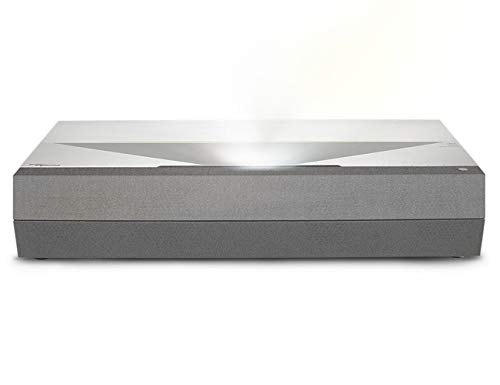
True Score
75770Experts
78405Customers
Mixed Reviews
 SAVE $200$1,999.00$1,799.00
SAVE $200$1,999.00$1,799.00Read More
Snapshot
Reasons to Buy
- Impressive brightness output
- High image quality
Reasons to Avoid
- High input lag
- Prone to rainbow artifacts
Specifications

Resolution 3840 x 2160 (4k) Refresh Rate 60 Hz 
Display Technology DLP 
Contrast Ratio 2,000,000:1 
Digital Keystone Yes 
HDR Yes 
Max Distance 17″ 
Max Screen Size 120″ 
3D Ready Yes 
Aspect Ratio 16:9 
Brightness 3000 lumens 
Depth 14.96″ 
HDMI Type 2.0 
Height 5.11″ 
Integrated Speakers Yes 
Light Source Laser 
Light Source Life 30,000 hrs 
Min Distance 6″ 
Min Screen Size 85″ 
Noise Level 26 dB 
Portable No 
Smart Functionality Amazon Alexa, Android TV, Google Assistant 
Sync Technology n/a 
TV Tuner No 
ThrowType Ultra Short Throw Technology 
Video Inputs Ethernet, HDMI 2.0, USB 
Weight 24.25 lbs 
Width 22″ All Specs
Test Results
SDR Brightness (Lumens) 2,488 HDR Brightness (Lumens) 1,990 Input Lag (ms) 70 Color Gamut % (Rec. 709) 117 Color Gamut % (DCI P3) 79 All Retailers
- $1,799.00$1,999Save $200
- $1,999.99
- $1,999.00
Our Verdict
If you’re looking for a projector to watch sports on, the Optoma CinemaX P2 is a fantastic choice. It boasts a high SDR brightness of 2488 lumens, ensuring images remain vivid and detailed even in rooms with lots of ambient light. The color accuracy is also excellent for the Rec. 709 color gamut (the gamut used for sports), featuring an exceptional coverage of 117%.
While the P2 is excellent, despite its strengths in providing excellent visibility and color performance, the CinemaX P2 is not as ideal for movies as the BenQ X3000i because it covers only 79% of the DCI P3 gamut while the X3000i has nearly perfect coverage. The higher input lag of 69.8 milliseconds also makes the P2 a poorer fit for gaming, as it’s high enough that delays start to become noticeable and create frustration when playing a game.
Still, the Optoma CinemaX P2 is a fairly priced, solid pick if your entertainment setup demands a projector that’ll adapt to different light conditions easily. Plus, with excellent coverage of the Rec. 709 coverage, it’s an excellent projector for watching sports, delivering fantastic colors and brightness on a screen that is much, much larger than something like a TV could provide.
Read Less

Best Overall

Runner Up

Best Value

Best Budget

Best Mid-Range

Premium Pick
Epson LS800B
A premium choice for diverse viewing needs, the Epson LS800B boasts 4084 lumens of brightness and exceptional color accuracy across multiple gamuts, though its higher price and 21.8 ms input lag may deter hardcore gamers.
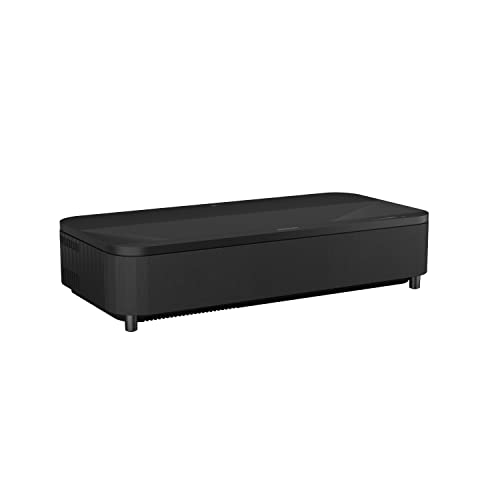
True Score
73754Experts
7698Customers
Mixed Reviews
 SAVE $500$3,499.99$2,999.99
SAVE $500$3,499.99$2,999.99Read More
Snapshot
Reasons to Buy
- Great brightness
- Good image quality
- Low input lag
- Ultra short throw
Reasons to Avoid
- Limited color gamut
- Limited connectivity
- Not 3D-enabled
Specifications

Resolution 3840 x 2160 (4k) Refresh Rate 240 Hz 
Display Technology 3LCD 
Contrast Ratio 2,500,000:1. 
Digital Keystone No 
HDR Yes 
Max Distance 19″ 
Max Screen Size 150″ 
3D Ready No 
Aspect Ratio 16:9 
Brightness 4000 Lumens 
Depth 13.4″ 
Height 6.1″ 
Integrated Speakers Yes 
Light Source Laser 
Light Source Life 10 years² 
Min Distance 11″ 
Min Screen Size 80″ No – 
Noise Level 19 dB 
Portable No 
Smart Functionality Android TV, Bluetooth, Energy-Saving, Remote, USB 
Sync Technology – 
TV Tuner – 
ThrowType 0.16 to 0.40:1 
Video Inputs HDMI 2.0, USB 
Weight 27 lbs 
Width 27.2″ All Specs
Test Results
SDR Brightness (Lumens) 4,084 HDR Brightness (Lumens) 0 Contrast Ratio (x:y) 0 Input Lag (ms) 22 Color Gamut % (Rec. 709) 0 Color Gamut % (DCI P3 uv) 93 SDR Brightness (nits) 0 HDR Brightness (nits) 0 SDR Color Temperature (K) 0 HDR Color Temperature (K) 0 Color Gamut % (Rec. 2020) 0 Color Gamut % (BT.2020) 0 Color Gamut % (BT. 709) 137 All Tests
All Retailers
- $2,999.99$3,500Save $500
Our Verdict
If you’re looking for a more premium bright room projector, the Epson LS800B excels as a versatile projector suited for a range of viewing conditions, particularly in bright rooms. It offers an impressive SDR brightness of 4084 lumens, ensuring images are visible and vibrantly displayed in environments with substantial ambient light. This high level of brightness is crucial for maintaining clear, crisp visuals during daytime viewing, making it an excellent choice for users who do not have the option to control natural light in their viewing spaces.
Color accuracy is another strong suit of the Epson LS800B, featuring a 92.60% coverage of the DCI P3 color space and a best-in-class 137.4% in the Rec. 709 spectrum. These coverages are phenomenal for most types of content, from playing games to watching sports to enjoying movies. Combined with the high brightness, the projector can tackle most ambient light without concerns over color washout and distortion.
However, with an input lag of 21.8 milliseconds, the Epson LS800B is less suited to gaming. It’s not terrible for it, but the lag will make a minor difference in particularly fast-paced competitive games. However, the delay for casual gaming will be virtually imperceptible and extremely smooth, thanks to the 240 Hz refresh rate.
The biggest drawback to the LS800B is that it’s expensive. As one of the most expensive projectors on our list, however, it also delivers excellent performance across the board and backs it up with brightness to easily tackle bright rooms. Its rich color output across two different gamuts, high brightness, decent input lag, and outstanding refresh rate make it nearly unbeatable in any scenario, from movies to games to sports – as long as you’ve got the money.
Read Less
Which Criteria Matters for Testing Best Projector for Bright Rooms?
Emphasizing these criteria (1 essential, 1 desirable) allows individuals to efficiently compare these projectors and their performance. This aids in making informed decisions and selecting a projector that fulfills all requirements.
| CRITERIA | RANGE | REQUIRED | DEFINITION |
|---|---|---|---|
| SDR Brightness (lumens) | > 2000 lumens | Yes | The amount of light the projector outputs from the lamp/bulb and projects onto the screen when playing SDR content. |
| Input Lag | < 100 ms | No (Nice to have) | The amount of time it takes for inputs to be registered and processed by the projector and shown on screen. |
Our Trusted Data Sources
We looked at 86+ projector reviewers and found that 16 are trustworthy (60%+ Trust Rating). The three we have listed below are our most trusted for projector.
- Pierre-Olivier Jourdenais – Rtings, LinkedIn
- Geoffrey Morrison – CNET, MuckRack
- Kam Valentine – Projector Reviews, MuckRack
Interested in a comprehensive analysis of our data sources? We’ve got you covered. Below, you’ll find a detailed list of every projector review website we’ve identified, organized by their respective Trust Ratings from highest to lowest. But we didn’t stop there. We’ve meticulously reviewed each publication and verified the data by checking whether the authors have bio links to MuckRack or LinkedIn. We’re committed to not only checking the facts but ensuring their veracity.
Projector Test Data & Results
Disclaimer:
Projectors are complex and difficult to test and evaluate, requiring extensive testing on the same level as televisions to paint a complete picture of how any given unit performs. Unfortunately, the testing behind projectors isn’t as rigorous, and a lot of the data we’ve compiled from expert reviewers has been incomplete at times. With different brightnesses measured from different sources, different color gamut tested and spotty contrast ratio measurements, we’ve done the best we can to leverage the available data when putting together these lists but have also trusted our True Score to help us make decisions when the data isn’t available.
1. SDR Brightness (lumens) Test Results
Projectors have two ways you can realistically measure brightness: in lumens or in nits. Lumens are more common, but brightness in general matters because projectors have to project light strongly enough that it overcomes ambient light without losing detail or color.
Most of the time, a projector is going to be used in a fairly dark room to help give the unit the best chance of displaying content the way it was intended, but higher lumens output let you watch content in progressively bright spaces – or across longer distances on bigger screens. For standard dynamic range content, we recommend at least 2000 lumens for most home applications, but more isn’t a bad thing, and 3000 lumens or more are ideal.
SDR Brightness (lumens)
> 2000 lumens
Acceptable range of performance
Definition: The amount of light the projector outputs from the lamp/bulb and projects onto the screen when playing SDR content, measured in lumens.
Units of Measurement: Lumens
Tools to Measure: Lux meter
Why It’s Important:
Lumens affect how an image is going to look when projected on a screen. If the projector isn’t putting out enough light, the image quality will suffer.
SDR Brightness (lumens; higher is better; 0 = No Data)
2. Input Lag (ms) Test Results
Input Lag (ms)
< 40 ms
Acceptable range of performance
Definition: The amount of time it takes for inputs to be registered and processed by the projector and shown on screen.
Units of Measurement: ms (milliseconds)
Tools to Measure: Input lag tool
Why It’s Important:
Low input lag is important to reduce delay when gaming.
Input lag is primarily an issue when it comes to playing video games on your projector. If you’re trying to enjoy fast-paced shooters or are using projector to play competitive modes, you’ll need a low input lag to “keep the projector out of your way”, so to speak. High input lag causes delays in your inputs and makes it harder to react to action on screen because your own physical reactions start to count for less than the projector’s ability to process what you’re doing.
For this reason, we recommend an input lag of 40 ms or less, but lower is always better, and for really competitive games we’d recommend less than 15 ms. Any more than that and your projector is better suited to playing games casually, though if you don’t play anything fast paced, input lag is less of an issue.
Input Lag (ms; lower is better; 0 = No Data)
Best Projector for Bright Rooms: Mistakes To Avoid
- Ignoring Brightness Levels: One of the most common mistakes is overlooking brightness levels. In bright rooms, ambient light can wash out the projected image, so opt for projectors with high brightness ratings (measured in lumens) to maintain picture clarity. For great projectors for daytime viewing, choose models with at least 2,000 lumens to ensure vivid and clear images even in well-lit conditions. To watch a projector during the day, focus on minimizing ambient light by using blackout curtains or screens designed to enhance brightness.
- Choosing Low Contrast Ratio: A low contrast ratio can result in washed-out images, especially in bright environments. Look for projectors with high contrast ratios to ensure vibrant colors and deep blacks, enhancing image quality even in well-lit rooms. Similarly to selecting an outdoor projector, it’s crucial to consider both high brightness and high contrast ratios to combat ambient light and deliver clear, vivid images, ensuring a great viewing experience.
- Neglecting Screen Quality: The type and quality of the projection screen can significantly impact image visibility in bright rooms. Avoid using screens with low gain or reflective surfaces, as they may exacerbate the effects of ambient light. Instead, opt for screens specifically designed for high ambient light environments.
- Not Considering Throw Ratio: The projector’s throw ratio determines the size of the image relative to the distance from the screen. In bright rooms, a short-throw projector may be preferable as it can produce a large image from a shorter distance, minimizing the impact of ambient light.
The Best Projector for Bright Rooms Tests Compared
Product |
True Score
|
SDR Brightness
|
Contrast Ratio
|
Color Gamut % (DCI P3 uv)
|
Input Lag (ms)
| |
|---|---|---|---|---|---|---|
| 85 |
|
|
|
| $1,799.00 $1,999 $200 |
| 83 |
|
|
|
| $1,660.89 |
| 75 |
|
|
|
| $1,799.00 $1,999 $200 |
73 |
|
|
|
| $2,999.99 $3,500 $500 |

